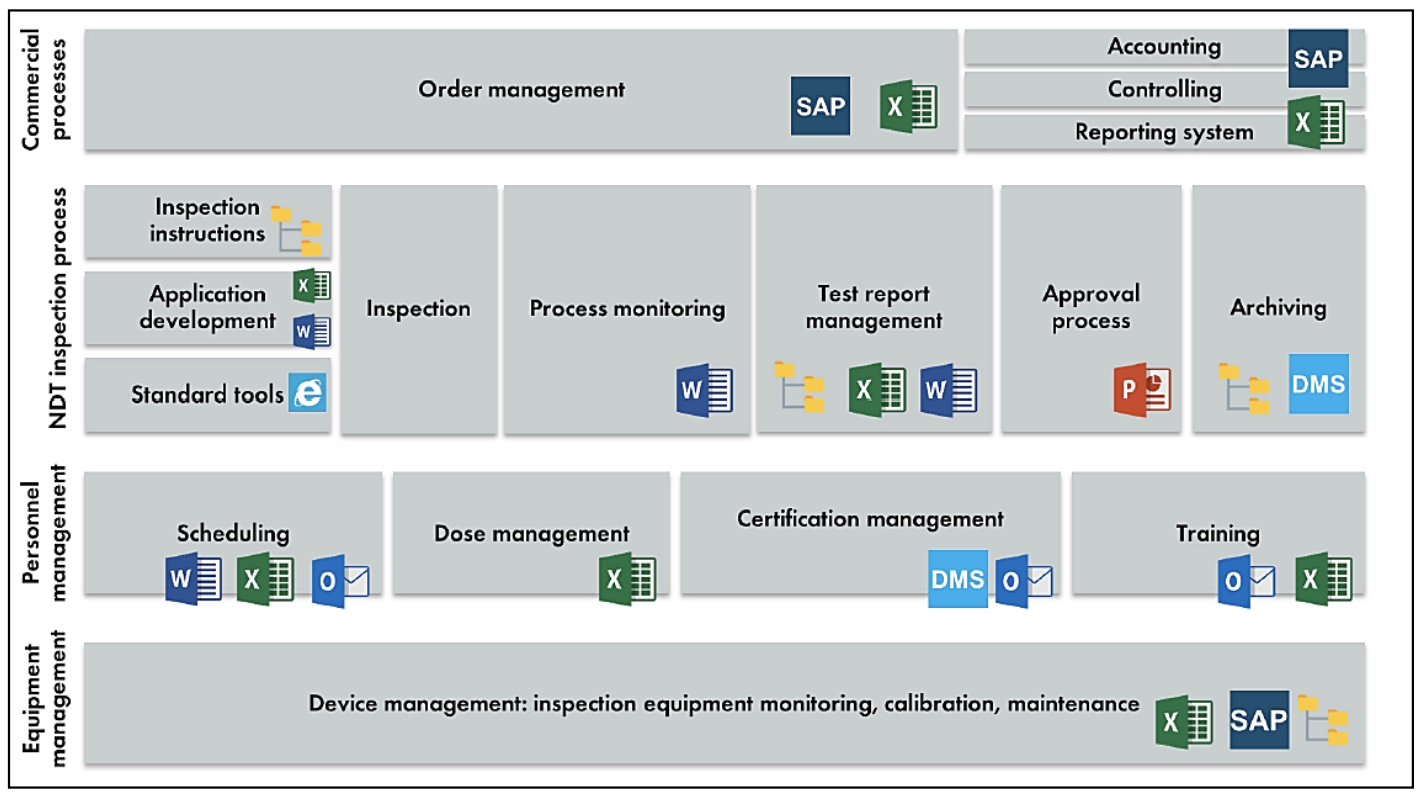Introduction
Nondestructive testing (NDT) is critical in the oil and gas industry. NDT allows oil and gas companies to inspect components and materials without impacting serviceability. If an item is found to be defective, it can be repaired instead of being replaced. NDT must be carried out accurately and efficiently to ensure equipment and systems are operating properly and safely. The single most important role of NDT is to ensure the safety of human life and environment.
Industry regulations, codes, and laws mandate NDT to ensure that piping systems, equipment, and instrumentation are operating reliably and safely. The American Society for Mechanical Engineers (ASME) and American Petroleum Institute (API) have several codes and standards that are followed. These codes and standards outline the rules and requirements for NDT.
Conventional NDT Workflow
There are many documents that must be managed and maintained to ensure compliance with industry standards. Documentation like inspection personnel records, NDT testing consumables, and the calibrated equipment being used must be continuously tracked to ensure that none are expired. In addition, inspections must be scheduled, test reports generated, approved, and archived.
Companies often deal with various tools like spreadsheets, hard copies, and software to cover the entire NDT workflow and to manage documentation. The effort to manage the separate systems in the daily operational business is time-consuming and data entry is redundant because the systems are not interconnected.
Comprehensive, workflow-specific information must be entered manually several times, which is also time-consuming and subject to human errors. The effort required to bring together the individual processes in day-to-day operations is enormous, and merging information from different systems is extremely difficult and prone to errors.
If it is discovered for example that an equipment calibration was found to be expired or that an inspector missed an eye exam because a spreadsheet was not checked prior to an inspection, test results may be declared invalid. The consequences are a repetition of the entire test or a recall if the part has already been placed in service and the expense for both could be significant. Because of the risks associated with managing and maintaining NDT workflow with spreadsheets and hard copies, it is critical for companies to look for ways to improve this process. The good news is that cloud-based NDT management software can improve workflow, productivity, and traceability by digitizing NDT workflow.
Figure 1 below illustrates the complexity and shows the many different moving pieces of a typical NDT workflow.

Digitized NDT Workflow
Cloud-based NDT management software provides the option of automating the entire NDT workflow in one application. Cloud-based applications organize and control the complete NDT order workflow including fully configurable and individual testing reports, all in a continuous process chain.
The entire NDT process landscape can be managed, including personnel management such as certification tracking, medical checks and dosage management of testing staff, administration of equipment and tools, and resources management. Each inspection workstation can be set up, providing inspectors with testing instructions, standards, and customer specifications.
The software can be set up with notification functions to ensure that testing consumables, devices, or personnel certificates that are due to expire are reported in real-time. Non-conformances to monitoring values are detected and notified by the software. In this way, supervisors or the NDT Level III technicians can intervene immediately in the inspection process and initiate corrective actions if required.
The concentration of the entire NDT workflow in a single system will also improve the efficiency of work assignments and the planning and execution of inspections. Automated data entry and transfer minimizes human transcription errors. Auditing will also be improved by streamlining access to qualification records, traceable test reports, and calibration records.
Implementation of a digital workflow can present some challenges and converting from manual to digital can seem overwhelming. Project managers can break the implementation process down by department and then enlist the help of department heads to digitize their processes one process at a time. Once a workflow application has been chosen the end user will need to schedule group product training sessions from the software supplier with tech-savvy team members who can then provide the software training to the rest of the team. By auditing their current workflow, the project manager can determine which processes will save the most time when automated.
Conclusion
The oil and gas industry is under a lot of pressure to cut costs due to current economic challenges brought on by inflation and other factors which have had a huge impact on revenue in the last couple of years. That combined with a competitive skilled labor and engineering market has companies looking for ways to lower operating costs.
Operating costs can be reduced by automating their NDT management systems by using an all-in-one software that integrates all NDT inspection methods and associated processes into a single system. Digitalization eliminates the need to use antiquated processes like multiple Excel files, Word documents, other software, or even paper. It organizes and controls the complete NDT order workflow in a continuous process chain that increases productivity, reduces human error, improves customer service, and provides real-time data tracking.
Converting to a digital workflow does take time, but it is important to understand that once implemented the time savings from automation is much more valuable than the time it takes to automate.
References
- Pulpstream, “6 Key Benefits of Digitizing Processes,” https://www.pulpstream.com/resources/blog/6-key-benefits-of-digitizing-processes#:~:text=Streamlining%20Workflows,process%20friction%2C%20and%20optimize%20workflows.
- PRNewswire, 2022, “DÜRR NDT Applauded by Frost & Sullivan for Digitizing and Streamlining Nondestructive Testing (NDT) Workflow With Its Seamless NDT Workflow Management Software,” Cision PR Newswire, https://www.prnewswire.com/news-releases/durr-ndt-applauded-by-frost--sullivan-for-digitizing-and-streamlining-nondestructive-testing-ndt-workflow-with-its-seamless-ndt-workflow-management-software-301512505.html
















Comments and Discussion
Add a Comment
Please log in or register to participate in comments and discussions.